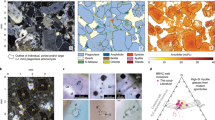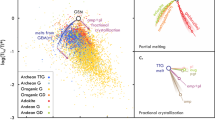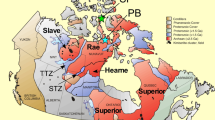Abstract
The solidified remnants of mafic magmatic systems host the greatest concentrations of platinum-group metals in the Earth’s crust. Our understanding of precious-metal mineralization in these intrusive bodies is underpinned by a traditional view of magma chamber processes and crystal mush solidification. However, considerable uncertainty remains regarding the physical and temporal controls on concentrating these critical metals, despite their importance to modern society. We present high-precision 87Sr/86Sr analyses of plagioclase and clinopyroxene from within centimetre-thick precious-metal-enriched layers in the Palaeogene open-system Rum layered intrusion (northwest Scotland). Isotopic heterogeneity is present between plagioclase crystals, between clinopyroxene and plagioclase and within plagioclase crystals throughout the studied section. On the basis of these observations, we demonstrate that platinum-group element mineralization formed by repeated small-volume reactive melt percolation events. The preservation of strontium isotope heterogeneities at 10–100 µm length scales implies cooling of the melts that formed the precious-metal-rich layers occurred at rates greater than 1 °C per year, and cooling to diffusive closure within tens to hundreds of years. Our data highlight the importance of cyclic dissolution–recrystallization events within the crystal mush and raise the prospect that precious-metal-bearing mafic intrusions may form by repeated self-intrusion during cooling and solidification.
This is a preview of subscription content, access via your institution
Access options
Access Nature and 54 other Nature Portfolio journals
Get Nature+, our best-value online-access subscription
$29.99 / 30 days
cancel any time
Subscribe to this journal
Receive 12 print issues and online access
$259.00 per year
only $21.58 per issue
Buy this article
- Purchase on Springer Link
- Instant access to full article PDF
Prices may be subject to local taxes which are calculated during checkout




Similar content being viewed by others
Data availability
The data generated during this study are all accessible in the main article and accompanying supplementary data files, and have also been deposited with the National Geoscience Data Centre of the British Geological Survey (https://dx.doi.org/10.5285/093ddaf1-789a-4b8f-aaca-af4d2f070134). Source data are provided with this paper.
References
Cawthorn, R. G., Barnes, S. J., Ballhaus, C. & Malitch, K. N. in Economic Geology: One Hundredth Anniversary Volume, 1905–2005 (eds Hedenquist, J. W. et al.) 215–249 (Society of Economic Geologists, 2005).
Naldrett, A. J. Magmatic Sulfide Deposits: Geology, Geochemistry and Exploration (Springer Verlag, 2004).
Naldrett, A. J. & Duke, J. M. Platinum metals in magmatic sulfide ores. Science 208, 1417–1424 (1980).
Eales, H. V. & Cawthorn, R. G. in Layered Intrusions (ed. Cawthorn, R. G.) 181–230 (Elsevier, 1996).
Godel, B. in Layered Intrusions (eds Charlier, B. et al.) 379–432 (Springer Science, 2015).
Mungall, J. E. & Naldrett, A. J. Ore deposits of the platinum-group elements. Elements 4, 253–258 (2008).
Latypov, R., Chistyakova, S., Page, A. & Hornsey, R. Field evidence for the in situ crystallization of the Merensky Reef. J. Petrol. 56, 2341–2372 (2015).
Naldrett, A. J., Gasparrini, E. C., Barnes, S. J., Von Gruenewaldt, G. & Sharpe, M. R. The upper critical zone of the Bushveld Complex and the origin of Merensky-type ores. Econ. Geol. 81, 1105–1117 (1986).
Boudreau, A. E. & McCallum, I. S. Concentration of platinum-group elements by magmatic fluids in layered intrusions. Econ. Geol. 87, 1830–1848 (1992).
Boudreau, A. Fluid fluxing of cumulates: the J-M reef and associated rocks of the Stillwater complex, Montana. J. Petrol. 40, 755–772 (1999).
Namur, O. et al. in Layered Intrusions (eds Charlier, B. et al.) 75–152 (Springer Science, 2015).
Holness, M. B., Humphreys, M. C. S., Sides, R., Helz, R. T. & Tegner, C. Toward an understanding of disequilibrium dihedral angles in mafic rocks. J. Geophys. Res. Solid Earth 117, B06207 (2012).
Cashman, K. V., Sparks, R. S. J. & Blundy, J. D. Vertically extensive and unstable magmatic systems: a unified view of igneous processes. Science 355, eaag3055 (2017).
Annen, C., Blundy, J. D. & Sparks, R. S. J. The genesis of intermediate and silicic magmas in deep crustal hot zones. J. Petrol. 47, 505–539 (2006).
Claiborne, L. L., Miller, C. F., Flanagan, D. M., Clynne, M. A. & Wooden, J. L. Zircon reveals protracted magma storage and recycling beneath Mount St. Helens. Geology 38, 1011–1014 (2010).
Cooper, K. M. & Kent, A. J. R. Rapid remobilization of magmatic crystals kept in cold storage. Nature 506, 480–483 (2014).
Emeleus, C. H., Cheadle, M. J., Hunter, R. H., Upton, B. G. J. & Wadsworth, W. J. in Layered Igneous Rocks. Developments in Petrology Vol. 15 (ed. Cawthorn, R. G.) 404–440 (Elsevier Science, 1996).
Brown, G. M. The layered ultrabasic rocks of Rhum, Inner Hebrides. Philos Trans. R. Soc. Lond. B 668, 1–53 (1956).
Bédard, J. H., Sparks, R. S. J., Renner, R., Cheadle, M. J. & Hallworth, M. A. Peridotite sills and metasomatic gabbros in the Eastern Layered Series of the Rhum Complex. J. Geol. Soc. Lond. 145, 207–224 (1988).
O’Driscoll, B., Day, J. M. D., Daly, J. S., Walker, R. J. & McDonough, W. F. Rhenium-osmium isotopes and platinum-group elements in the Rum Layered Suite, Scotland: implications for Cr-spinel seam formation and the composition of the Iceland mantle anomaly. Earth Planet. Sci. Lett. 286, 41–51 (2009).
Hamilton, M. A., Pearson, D. G., Thompson, R. N., Kelley, S. P. & Emeleus, C. H. Rapid eruption of Skye lavas inferred from precise U–Pb and Ar–Ar dating of the Rum and Cuillin plutonic complexes. Nature 394, 260–263 (1998).
O’Driscoll, B., Emeleus, C. H., Donaldson, C. H. & Daly, J. S. Cr-spinel seam petrogenesis in the Rum Layered Suite, NW Scotland: cumulate assimilation and in situ crystallization in a deforming crystal mush. J. Petrol. 51, 1171–1201 (2010).
Tepley, F. J. III & Davidson, J. P. Mineral-scale Sr-isotope constraints on magma evolution and chamber dynamics in the Rum layered intrusion, Scotland. Contrib. Mineral. Petrol. 145, 628–641 (2003).
Palacz, Z. A. & Tait, S. R. Isotopic and geochemical investigation of unit 10 from the Eastern Layered Series of the Rhum intrusion, Northwest Scotland. Geol. Mag. 122, 485–490 (1985).
Hepworth, L. N., O’Driscoll, B., Gertisser, R., Daly, J. S. & Emeleus, C. H. Incremental construction of the Unit 10 peridotite, Rum Eastern Layered Intrusion, NW Scotland. J. Petrol. 58, 137–166 (2017).
Holness, M. B., Hallworth, M. A., Woods, A. & Sides, R. E. Infiltration metasomatism of cumulates by intrusive magma replenishment: the Wavy Horizon, Isle of Rum, Scotland. J. Petrol. 48, 563–587 (2007).
Leuthold, J., Blundy, J. D., Holness, M. B. & Sides, R. Successive episodes of reactive liquid flow through a layered intrusion (Unit 9, Rum Eastern Layered Intrusion, Scotland). Contrib. Mineral. Petrol. 167, 1021–1038 (2014).
Morse, S. A. Basalts and Phase Diagrams (Springer, 1980).
Upton, B. G. J. et al. Picritic magmas and the Rum ultramafic complex, Scotland. Geol. Mag. 139, 437–452 (2002).
Pec, M., Holtzman, B. K., Zimmerman, M. & Kohlstedt, D. L. Reaction infiltration instabilities in experiments on partially molten mantle rocks. Geology 43, 575–578 (2015).
Spiegelman, M., Kelemen, P. B. & Aharonov, E. Causes and consequences of flow organization during melt transport: the reaction infiltration instability in compactible media. J. Geophys. Res. Solid Earth 106, 2061–2077 (2001).
Donaldson, C. H. The rates of dissolution of olivine, plagioclase and quartz in a basaltic melt. Mineral. Mag. 49, 683–693 (1985).
Giletti, B. J. & Casserly, J. E. D. Strontium diffusion kinetics in plagioclase feldspars. Geochim. Cosmochim. Acta 58, 3785–3793 (1994).
Sneeringer, M., Hart, S. R. & Shimizu, N. Strontium and samarium diffusion in diopside. Geochim. Cosmochim. Acta 48, 1589–1608 (1984).
Reddy, S. M., Kelley, S. P. & Wheeler, J. A. 40Ar/39Ar laser probe study of micas from the Seisa zone, Italian Alps: implications for metamorphic and deformation histories. J. Metamorph. Geol. 14, 493–508 (1996).
Mungall, J. E., Kamo, S. L. & McQuade, S. U–Pb geochronology documents out-of-sequence emplacement of ultramafic layers in the Bushveld Igneous Complex of South Africa. Nat. Commun. 7, 13385 (2016).
Robb, S. J. & Mungall, J. E. Testing emplacement models for the Rustenburg Layered Suite of the Bushveld Complex with numerical heat flow models and plagioclase geospeedometry. Earth Planet. Sci. Lett. 534, 116084 (2020).
Wall, C. J. et al. The Stillwater Complex: integrating zircon geochronological and geochemical constraints of the age, emplacement history and crystallization of a large, open-system layered intrusion. J. Petrol. 59, 153–190 (2018).
Latypov, R., Chistyakova, S. & Kramers, J. Arguments against syn-magmatic sills in the Bushveld Complex. S. Afr. J. Geol. 120, 565–574 (2017).
Latypov, R. M. Comment on “The Stillwater Complex: integrating zircon geochronological and geochemical constraints on the age, emplacement history and crystallization of a large, open-system layered intrusion” by Wall et al. (J. Petrology, 59, 153–190, 2018). J. Petrol. 59, 153–190 (2019).
Miller, C. F. et al. Growth of plutons by incremental emplacement of sheets in a crystal-rich host: evidence from Miocene intrusions of the Colorado River region, Nevada, USA. Tectonophysics 500, 65–77 (2011).
Davidson, J. P., Tepley, F. J. III & Knesel, K. M. Isotopic fingerprinting may provide insights into evolution of magmatic systems. EOS Trans. 79, 185, 189, 193 (1998).
Charlier, B. L. A. et al. Methods for the microsampling and analysis of strontium and rubidium isotopes at single crystal scale for petrological and geochronological applications. Chem. Geol. 232, 114–133 (2006).
Certificate of Analysis: Standard Reference Material 987 (NIST, 2007).
Schannor, M. et al. Small-scale Sr and O isotope variations through the UG2 in the eastern Bushveld Complex: the role of crustal fluids. Chem. Geol. 485, 100–112 (2018).
Acknowledgements
L.N.H. acknowledges funding from a Natural Environmental Research Council (NERC) Studentship (grant no. 1361482) and Keele University. We thank Scottish National Heritage (SNH) for sampling permission on Rum during 2014 and 2015. We thank P. Greatbatch and D. Wilde (Keele University) for thin-section preparation and A. Kronz and G. Breedveld for assistance with EMPA analysis at the University of Göttingen. We also thank H. Horsch for her assistance generating the QEMSCAN images and M. Murphy (UCD) for technical assistance. Strontium isotopic analyses were carried out at the National Centre for Isotope Geochemistry (NCIG), Dublin, which is a joint venture of University College Dublin, Trinity College Dublin, University College Cork and National University of Ireland Galway, funded mainly by Science Foundation Ireland, including grant no. 04/BR/ES0007/EC07 awarded to J.S.D. J.S.D. was also supported in part by Science Foundation Ireland grant no. 13/RC/2092, which is co-funded under the European Regional Development Fund. We thank J. Day for helpful comments on an earlier version of the manuscript.
Author information
Authors and Affiliations
Contributions
B.O’D. conceived the study. B.O’D., L.N.H. and J.S.D. designed the programme of work. L.N.H. carried out fieldwork and EMPA analyses. L.N.H. and J.S.D. carried out the chemistry and mass spectrometry for strontium isotope analysis. B.O’D. and C.G.J. did the Sr diffusion-related calculations. All authors contributed to interpreting the results. B.O’D. wrote the manuscript. B.O’D., J.S.D., L.N.H., R.G. and C.G.J. contributed to editing the final version.
Corresponding author
Ethics declarations
Competing interests
The authors declare no competing interests.
Additional information
Peer review information Primary Handling Editor: Rebecca Neely.
Publisher’s note Springer Nature remains neutral with regard to jurisdictional claims in published maps and institutional affiliations.
Extended data
Extended Data Fig. 1 Thin section photomicrographs of Unit 10 Cr-spinel seams.
Transmitted light (crossed polars) photomicrographs of microstructures associated with the lower peridotite Cr-spinel seams. a, Chain-textured arrangement of Cr-spinel around olivine primocrysts (and embedded in interstitial plagioclase) in a typical ~1-cm-thick seam. The white arrows point to embayments in olivine crystals that are occupied by Cr-spinel crystals. b, Example of a much less diffuse Cr-spinel seam than in (a) (black; this one may be chromitite proper). Note the olivine primocryst grainsize change across the seam. The yellow arrows point to the triple junctions between olivine crystals in the finer-grained peridotite, which suggest an approach to solid-state textural equilibrium. c, Oscillatory zoned interstitial plagioclase in a Cr-spinel seam. The brightly coloured crystals on all sides are olivine.
Extended Data Fig. 2 Element maps of plagioclase in the Unit 10 lower peridotite.
Element maps (Na) showing typical textures of intercumulus plagioclase in Cr-spinel seams from the Unit 10 lower peridotite. a, Oscillatory zoning of intercumulus plagioclase between olivine primocrysts. The smaller unlabelled black crystals are Cr-spinel. b, Chain-textured arrangement of Cr-spinel (small black-coloured) crystals around olivine crystals (labelled ol) in a Unit 10 Cr-spinel seam. Note the variation in intercumulus plagioclase composition and the tendency for Cr-spinel to occur in more anorthitic plagioclase. c, Compositional variation in intercumulus plagioclase from adjacent to a Unit 8 Cr-spinel seam. As for (b) above, note the occurrence of Cr-spinel in the more anorthitic plagioclase, supporting the argument that Cr-spinel crystallized by a peritectic reaction between picrite and relatively sodic plagioclase d, Complex compositional variation in intercumulus plagioclase (orange-green). The blue-coloured crystal is clinopyroxene.
Extended Data Fig. 3 QEMSCAN and back-scattered electron images of platinum-group mineral phases in a Unit 10 Cr-spinel seam.
a, QEMSCAN image of diffuse platinum-group mineral bearing Cr-spinel seam illustrating the general distribution and style of PGE mineralization in the Unit 10 lower peridotite. The solid black line illustrates the top boundary of the seam. The lower boundary is more diffuse and is mainly out of the image frame. b, Close up image of the area outlined in the red box in (a), illustrating the occurrence of sulfides at olivine three grain junctions. c–f, Back-scattered electron micrograph images of platinum-group minerals from the seam in (a), associated with base-metal sulfides. The labelled red circles in (a) correspond to the locations in the sample of the images in c-f. Abbreviations as follows: Pn – pentlandite; Fe-ox – magnetite or ferrian Cr-spinel; ol – olivine.
Extended Data Fig. 4 Unit 10 plagioclase mineral chemical data plots.
Plagioclase compositional variations as measured by electron microprobe. a–d, are K2O (wt.%), TiO2 (wt.%), FeO (wt.%) and Sr (ppm) versus An content, respectively. The black-filled symbols represent analyses from Cr-spinel seams in the Unit 10 lower peridotites not studied further (i.e., for 87Sr/86Sr) here. Note the strong anti-correlation of plagioclase TiO2 with anorthite content, linking the crystallization of Cr-spinel with that of relatively anorthitic plagioclase; with the onset of crystallization of Cr-spinel, Ti preferentially partitioned into it. Vertical bars show 2σ uncertainties.
Extended Data Fig. 5 Unit 10 clinopyroxene mineral chemical data plots.
Clinopyroxene compositional variations as measured by electron microprobe. a, Al2O3 (wt.%) versus Mg# [Mg# = Mg/(Mg+Fe2++Mn)*100]; b, TiO2 (wt.%) versus Mg#; c, Cr2O3 (wt.%) versus Al2O3 (wt.%); (d) Na2O (wt.%) versus Cr2O3 (wt.%). The black-filled symbols represent analyses from Cr-spinel seams in the Unit 10 lower peridotites not studied further (i.e., for 87Sr/86Sr).
Supplementary information
Supplementary Information
Supplementary Fig. 1 contains contextual field data for the samples analysed in this study, including geological maps and petrological logs of the sampled sequences.
Supplementary Data 1
Supplementary Tables 1–5 of EMPA and strontium isotope data, including additional back-scattered electron images of analysed crystals.
Supplementary Data 2
Source data for Supplementary Fig. 1.
Source data
Source Data Fig. 2
Source data for Fig. 2.
Rights and permissions
About this article
Cite this article
Hepworth, L.N., Daly, J.S., Gertisser, R. et al. Rapid crystallization of precious-metal-mineralized layers in mafic magmatic systems. Nat. Geosci. 13, 375–381 (2020). https://doi.org/10.1038/s41561-020-0568-3
Received:
Accepted:
Published:
Issue Date:
DOI: https://doi.org/10.1038/s41561-020-0568-3
This article is cited by
-
Chromitite layers indicate the existence of large, long-lived, and entirely molten magma chambers
Scientific Reports (2022)
-
High-fidelity and high-resolution phase mapping of granites via confocal Raman imaging
Scientific Reports (2021)
-
The Rustenburg Layered Suite formed as a stack of mush with transient magma chambers
Nature Communications (2021)
-
Formation of Bushveld anorthosite by reactive porous flow
Contributions to Mineralogy and Petrology (2021)
-
Lateral variations in the Unit 7–8 boundary zone of the Rum Eastern Layered Intrusion, NW Scotland: implications for the origin and timing of Cr-spinel seam formation
Contributions to Mineralogy and Petrology (2020)



